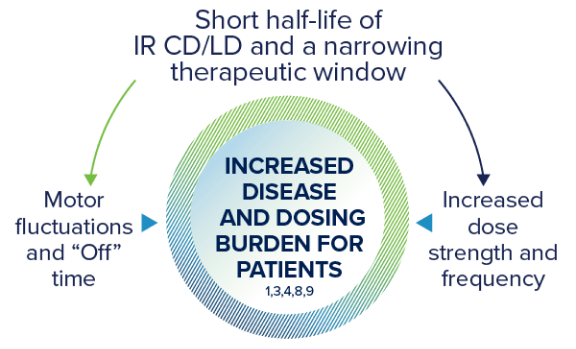Limitations of IR CD/LD
While IR CD/LD has been the gold standard in PD treatment for over 50 years, it has limitations1,2
Even with optimal management, frequent dosing and “Off” time with IR CD/LD can lead to increased burden and reduced quality of life for patients as PD progresses3-7


*Analysis was conducted on data from 5971 non-Hispanic White patients. Approximately 50% of patients reported “Off” episodes.10
†87.2% of patients (out of 617 patients) in the study were on IR and controlled-release LD therapy. Study included 415 patients with PD who reported wearing “off” in a self-administered questionnaire, including 23 patients with disease duration less than 2.5 years.11
CD/LD=carbidopa/levodopa; IR=immediate-release; LD=levodopa; PD=Parkinson’s disease.
See what makes CREXONT® (carbidopa and levodopa) extended-release capsules different
IMPORTANT SAFETY INFORMATION
Indications and Usage
CREXONT® (carbidopa and levodopa) extended-release capsules for oral use is indicated for the treatment of Parkinson’s disease, post-encephalitic parkinsonism, and parkinsonism that may follow carbon monoxide intoxication or manganese intoxication in adults.Dosage and Administration
- Levodopa-naïve patients: Starting dose is 35 mg carbidopa/140 mg levodopa taken orally twice daily for the first three days; thereafter, dosage may be increased gradually as needed
- For patients converting to CREXONT from immediate-release carbidopa/levodopa, dosages are not substitutable on a 1:1 basis. See full prescribing information Section 2.2 for instructions
- For patients converting from Rytary® (carbidopa and levodopa) extended-release capsules, initiate CREXONT on an approximately 1:1 mg basis using the levodopa component for conversion
- CREXONT may be taken up to four times daily. The maximum recommended daily dosage is 525 mg carbidopa/2100 mg levodopa
- CREXONT may be taken with or without food. Capsules should not be chewed, divided or crushed
- CREXONT should not be taken with alcohol
Contraindications
Nonselective MAO inhibitors.Warnings and Precautions
- CREXONT may cause falling asleep during activities of daily living, somnolence or dizziness. Patients should avoid activities that require alertness such as driving and operating machinery until they know how CREXONT affects them
- It is important to avoid sudden discontinuation or rapid dose reduction to reduce the risk of withdrawal symptoms such as high fever or confusion. Patients who are discontinuing CREXONT should taper off with healthcare provider guidance
- Consider dose reductions or stopping CREXONT in patients with hallucinations or impulse control disorders (e.g., gambling, sexual urges, or uncontrolled spending)
- Consider dose reduction in patients with dyskinesia
- Patients with a major psychotic disorder should not be treated with CREXONT
- Monitor patients with a history of cardiovascular disease for cardiac function
- Monitor patients with a history of peptic ulcer for upper GI hemorrhage
- Monitor patients with glaucoma for increased intraocular pressure
Adverse Reactions
The most common adverse reactions (incidence ≥ 3% and greater than immediate-release CD/LD) are nausea and anxiety.Drug Interactions
Iron salts and dopamine D2 antagonists, including metoclopramide, may reduce the effectiveness of CREXONT.Use in Specific Populations
Pregnancy: Based on animal data, CREXONT may cause fetal harm. There are no adequate data on the developmental risk associated with the use of CREXONT in pregnant women.Breastfeeding: The developmental and health benefits of breastfeeding should be considered along with the mother’s clinical need for CREXONT.
Geriatric patients: There were no differences in safety outcomes between patients less than 65 years of age, 65-75 years of age, or 75 years and older.
To report SUSPECTED ADVERSE REACTIONS, contact Amneal Specialty, a division of Amneal Pharmaceuticals, LLC at 1‑877‑835‑5472 or the FDA at 1‑800‑FDA‑1088 or www.fda.gov/medwatch.
Please see full Prescribing Information for CREXONT.
Content is for guidance only. Please use clinical judgment when prescribing CREXONT. Dosage is individualized for each patient.
References: 1. LeWitt P, Ellenbogen A, Burdick D, et al. Improving levodopa delivery: IPX203, a novel extended-release carbidopa-levodopa formulation. Clin Park Relat Disord. 2023;8:100197. 2. Espay AJ, Pagan FL, Walter BL, et al. Optimizing extended-release carbidopa/levodopa in Parkinson disease: consensus on conversion from standard therapy. Neurol Clin Pract. 2017;7(1):86-93. 3. Oonk NGM, Movig KLL, Munster EM, Koehorst-Ter Huurne K, van der Palen J, Dorresteijn LDA. The effect of a structured medication review on quality of life in Parkinson’s disease: the study protocol. Contemp Clin Trials Commun. 2019;13:100308. 4. Calabresi P, Di Filippo M, Ghiglieri V, Tambasco N, Picconi B. Levodopa-induced dyskinesias in patients with Parkinson’s disease: filling the bench-to-bedside gap. Lancet Neurol. 2010;9(11):1106-1117. 5. Soileau M, Pagan F, Fasono A, et al. Comparative effectiveness of carbidopa–levodopa enteral suspension and deep brain stimulation on Parkinson’s disease-related pill burden reduction in advanced Parkinson’s disease: a retrospective real-world cohort study. Neurol Ther. 2022;11(2):851-861. 6. Rodríguez-Violante M, Ospina-García N, Dávila-Avila NM, Cruz-Fino D, Cruz-Landero ADL, Cervantes-Arriaga A. Motor and non-motor wearing-off and its impact in the quality of life of patients with Parkinson’s disease. Arq Neuropsiquiatr. 2018;76(8):517-521. 7. Modi NB, Mittur A, Rubens R, Khanna S, Gupta S. Single-dose pharmacokinetics and pharmacodynamics of IPX203 in patients with advanced Parkinson disease: a comparison with immediate-release carbidopa-levodopa and with extended-release carbidopa-levodopa capsules. Clin Neuropharmacol. 2019;42(1):4-8. 8. Olanow CW, Obeso JA, Stocchi F. Drug insight: continuous dopaminergic stimulation in the treatment of Parkinson’s disease. Nat Clin Pract Neurol. 2006;2(7):382-392. 9. Cenci MA. Presynaptic mechanisms of L-DOPA-induced dyskinesia: the findings, the debate, and the therapeutic implications. Front Neurol. 2014;5:242. 10. Devraj R, Elkouzi A, Tracey MR. Real-world experiences of Parkinson’s disease OFF time and role of demographics. J Patient Cent Res Rev. 2024;11(1):8-17. 11. Stocchi F, Antonini A, Barone P, et al. Early detection of wearing off in Parkinson disease: the DEEP study. Parkinsonism Relat Disord. 2014;20(2):204-211.

